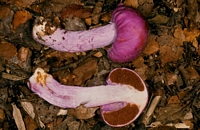|
 Cortinarius porphyroideus Cortinarius porphyroideus
SynonymsThaxterogaster porphyreus
Secotium porphyreum
Secotium lilacense
Thaxterogaster erythropus
BiostatusPresent in region - Indigenous. Endemic
Images (click to enlarge)
Caption: Dried type specimen
Owner: Herb PDD | 
Owner: Herb. PDD | 
Caption: Thaxterogaster porphyreum (Cunningham) Singer (ZT
69/10): a. fruitingbody; (ZT 67/169): b. fruitingbody; (ZT 68/57): c. fruitingbody;
(ZT 67/191): d. fruitingbody; (type): e. spores, f. basidia, g. cuticle. | 
Owner: J.A. Cooper | 
Owner: Herb. PDD | 
Owner: J.A. Cooper | 
Caption: REB 795
Owner: Ross Beever | 
Caption: Watercolour
Owner: G.M. Taylor | 
Owner: J.A. Cooper | 
Caption: ZT8468
Owner: E. Horak: © Creative Commons Attribution-Noncommercial 3.0 New Zealand | 
Caption: ZT0761
Owner: E. Horak: © Creative Commons Attribution-Noncommercial 3.0 New Zealand | 
Caption: ZT68-057
Owner: E. Horak: © Creative Commons Attribution-Noncommercial 3.0 New Zealand | 
Caption: ZT67-166
Owner: E. Horak: © Creative Commons Attribution-Noncommercial 3.0 New Zealand |
Article: Horak, E. (1973). Fungi Agaricini Novazelandiae I-V. Beihefte zur Nova Hedwigia 43: 200 p.
Description: The
fruitingbodies of this common fungus in New Zealand can vary considerably in
shape and size as is shown in Fig. 3 a-d. Excellent descriptions have been given
by Cunningham (1942: 84), Heim (1951: 129) and Singer & Smith (1958: 212)
but the white veil remnants scattered along the margin of the gastrocarp or
along the stipe hitherto have been overlooked. All collections kept in our herbarium
showed in fresh conditions obvious veil remnants, which cover parts of the peridium
and still more frequently the lower portion of the stipe.
Spores
12-1.5 x 7.5-9.5 µm, ellipsoid to ellipsoid-oblong, rust brown, verrucose, mostly
axially symmetric, perisporium poorly developed or lacking. Basidia 35-50 x
10-14 µm 4-spored. Cystidia absent. Epicutis consisting of interwoven, gelatinised,
hyaline hyphae (2-6 µm diam.) forming a cutis, hyphae of subcutis cylindrical,
with thin-walled membrane and epimembranous pigment. Clamp connections present,
but sometimes rare.
Habitat: On
ground amongst litter of Nothofagus fusca, N. menziesii, N. solandri, N.
cliffortioides. New Zealand.
Notes: This
species represents one of the most common fungi in all types of New Zealand
Nothofagus forests. Th. porphyreum (Cunningham) also occurs during
mild winter and its purple colours have attracted the attention of mycologists
and naturalists alike.
Article: Cunningham, G.H. (1924). A critical revision of the Australian and New Zealand species of the genus Secotium. Proceedings of the Linnean Society of New South Wales 49(2): 97-119.
Description: Peridium violet, depressed-globose, base truncate, deeply excavated, up to 7 cm. high, and 7
cm. broad, smooth, glabrous, polished, viscid; drying pallid-brown, becoming rugulose. Stipe
pallid-violet, tinted yellow at the base, stout, 3-9 cm. long, 10-20 mm. wide at the base,
tapering to the apex, fibrillose, minutely striate, hollow; columella slightly expanded at the
apex. Gleba pallid ferruginous, labyrinthiform or cellular, cells 1-2 mm. long, numerous,
dissepiments thick. Spores coarsely verruculose, chestnut-brown, ovate, one end rounded, the
other pointed, 12-17 x 8-11 µ, epispore thin.
Habitat: Habitat. Solitary on the ground in beech forest. (Nothofagus sp.).
Notes: This species is characterised by the large size and violet colour of the peridium. It is not
uncommon in a certain beech forest near Wellington, appearing there during the winter
months, usually after heavy rain. At first it is buried in the ground, often in clayey soil, but as
it approaches maturity it appears on the surface. When submerged it is a pallid white, but as
soon as it is exposed to the light it changes colour; that this change is effected by light is
obvious when a specimen that has partially emerged is examined, for it is then seen that the
portion above the ground is violet, but that the remainder is white. The peridium is deleidedly
viscid when fresh.
In its younger stages the plant is readily confused with Gallacea scleroderma (Cke.) Lloyd, as
in colour and hypogeal habit it resembles this species; but when the peridium is sectioned the
plants may be readily separated.
|